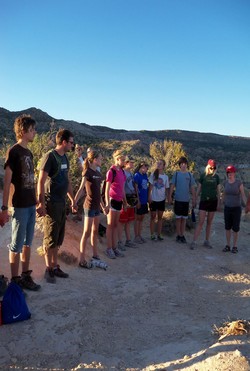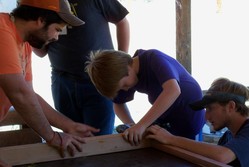When Mark Zaineddin was a seminary student, he had no idea he’d wind up working at a Presbyterian conference center, much less working with youth. In fact, when he received a call asking him to consider serving as summer chaplain at Ghost Ranch, he had never heard of the conference center.
“I said, ‘Thanks, but no thanks,’ but wound up coming out as a seminary intern to be a summer chaplain,” Zaineddin said. In the three years since, he’s helped Ghost Ranch develop the Youth Service Corps, which gives junior and senior high schoolers opportunities for service at the ranch and surrounding communities.
How did one summer turn into three years?
“Well, this place transformed me. Just like I think it transforms a lot of people,” Zaineddin said.
Though Ghost Ranch has a long history with its adult service corps, there was not an equivalent for youth.
“Mark initiated the idea of doing the same thing with youth groups and individuals as we have done with the adults,” said Ed DeLair, the ranch’s director for educational programs
“I was pretty adamant that if we were going to do this, at least half or more of our work needed to be in the surrounding community,” Zaineddin said. “The ranch has a long history of community outreach, and this was another way to foster that.
“In my opinion, everything is relational,” he said. “I also think that we, as a large working ranch, have a responsibility to those in the community — it is a privilege but also a responsibility for us to be here.”
When Zaineddin arrived at Ghost Ranch, he was new to the area, with no local contacts.
“I remember the first year I was worried that we wouldn’t have enough service partners to give work to the groups who were coming,” said Zaineddin. “Then all of a sudden we had a proliferation of organizations and I thought, ‘Oh no, how are we going to commit to them all?’
“We are a neighbor to so many different communities and people of diverse ethnic, religious and cultural traditions that we not only have the luxury but also the responsibility to be in conversation and interaction with our neighbors,” he said.
Another component that Zaineddin saw as integral to the creation of the service corps was that the work was contextualized.
“If we go out to the Benedictine monastery, Christ in the Desert, I want the youth to engage in conversation with some of the monks about what it means to be living the monastic life in the 21st century,” said Zaineddin.
Another of the partners is Adobe in Action, which builds houses in a model similar to Habitat for Humanity, but using locally made adobe bricks. The Youth Service Corps students make the bricks that will eventually go into the building of a house.
“Using clay and sand and straw to build bricks, how does a young girl from Baltimore or a young boy from Tulsa contribute to continuing this tradition? How do these youth take what they’ve been enriched in home with them?” Zaineddin acknowledged that most places will likely not be building out of adobe, but, at the same time, housing is a national issue with all sorts of points of connection.
“We may, in the course of vespers or conversation while working, then talk about housing issues in Tulsa or Baltimore, so that they don’t leave here with a powerful experience but one that they don’t know how to relate at home.”

Participants are also exposed to the cultural and recreational experiences Ghost Ranch offers. —Photo credit: Ghost Ranch
But the Youth Service Corps is not just about service. “I was also pretty adamant that, in addition to the service, the youth, many of whom have traveled here from all parts of the U.S., need to be culturally and recreationally exposed to Ghost Ranch as well,” said Zaineddin.
But all of it — the outreach, the contextualization, and even the recreation — is rooted in a daily rhythm that begins each day with intergenerational worship and closes it with evening vespers.
“I think it is an important grounding for the youth that also exposes them to the others who are at the ranch,” Zaineddin said.
“It’s certainly been a program that I believe is not only changing directly and indirectly the lives that we are performing the service for, but in so many ways it has transformed the youth, adult leaders and staff that have worked on this program.”
Interested in participating next summer either as an individual traveling to the ranch with your family or as part of a youth group? More info can be found on Ghost Ranch’s website or by calling the ranch at (505) 685-4333.
Erin Dunigan is a freelance writer, photographer, and pastor who lives in a small coastal community in Baja California, Mexico when she is not following her wanderlust out into the world.

